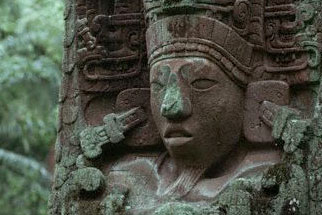 The other great civilization of Middle America, and the most highly
developed in the arts and sciences, was that of the Mayas, whose territory
encompassed the Yucatan peninsula, southern Mexico, Guatemala, Belize
and parts of Honduras and El Salvador. Its Classic manifestation occurred
between ad 300 and 900 in the Peten jungle of northern Guatemala, though
it is believed that Maya culture may have originated in around 1000 bc on
the coast of the Gulf of Mexico in the area near Veracruz, which also saw
the rise of Olmec culture. If so, Maya culture would have been remotely
cognate with the Aztec.
The other great civilization of Middle America, and the most highly
developed in the arts and sciences, was that of the Mayas, whose territory
encompassed the Yucatan peninsula, southern Mexico, Guatemala, Belize
and parts of Honduras and El Salvador. Its Classic manifestation occurred
between ad 300 and 900 in the Peten jungle of northern Guatemala, though
it is believed that Maya culture may have originated in around 1000 bc on
the coast of the Gulf of Mexico in the area near Veracruz, which also saw
the rise of Olmec culture. If so, Maya culture would have been remotely
cognate with the Aztec.
Classic Maya society fell victim to the mysterious decline that first afflicted Teotihuacan. By the middle of the eighth century the Classic sites in the Peten had been abandoned. In about ad 900 a Post-Classic Maya culture emerged at the northern tip of the Yucatan peninsula; this was the result of a fusion with elements of central Mexican culture brought to the Yucatan by Toltec invaders, who conquered Yucatan and made their capital at Chichen Itza, introducing new styles of architecture and art. The power of Chichen Itza had declined by the thirteenth century and it was succeeded by a new empire, whose centre was at Mayapan, but this too had disintegrated into smaller states by the time the Spaniards arrived.
The economy of the Mayas was based on maize, which was cultivated by slash-and-burn methods that exhausted the soil within a short period. A consequence of this form of agriculture was a tendency for peasants to live in makeshift settlements of pole and thatch rather than in villages. Maya cities were therefore less concentrated than those in central Mexico, and were primarily religious and administrative centres, where the priesthood and the nobility lived, though it appears that there was more residential settlement by the common people than was previously thought, especially in the main cities of northern Yucatan like Chichen Itza and Mayapan.
Maya kingdoms were ruled by a leader with religious as well as political authority; society was divided into a class of commoners on the one hand and an upper class of priests, warriors and administrators on the other. 'Empires' were created when a kingdom was able to exact tribute and labour from other smaller states. Like the Aztecs, the Mayas believed that a succession of worlds had been created and destroyed, and that the present era would also have an apocalyptic ending. To put off this calamity they sacrificed human beings and practiced various forms of expiation. Their concern with the fate of the cosmos produced a complex calendrical system and a well- developed mathematics, which discovered the concept of zero several centuries before any other people in history. Hieroglyphic writing appears on stelae, on temple walls and doorways, and in a number of codices; otherwise Maya culture was oral and rich in mythology, of which something has been preserved in the Popol Vuh, the sacred book of the Quiche Maya of Guatemala, which was written in the European alphabet from oral sources after the Spanish Conquest. In architecture the Mayas surpassed other Amer-Indian civilizations; they were highly skilled in stone sculpture and mural painting, as is evidenced by the frescoes at Bonampak in Chiapas.